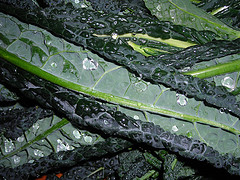- SPIN — an intensive system of farming — has branched out into gardening for food.
- Oxford boffins discuss food. Interminably. Every year. Jeremy says: I was there!
- Slate bends over backwards to think of ways GMOs can be good for you.
- Open source food. Great concept, great talk.
- Feral and native bees could take up the slack caused by Colony Collapse Disorder.
Surfing for seaweed
I’ve been sick at home for the past few days with what the wife is pleased to refer to as a man-cold but I think is a middling form of bubonic plague: bad enough to keep me from getting out of bed, not bad enough to prevent me surfing the tubes. Anyway, it’s amazing what you can learn when you have the time to follow links to your heart’s content. I won’t go into the details of how I got there, although it was actually rather fun, but anyway, for example, this evening I landed totally serendipitously, after quite a meander from something totally unrelated, on a website of genuine agrobiodiversity interest. It’s about Porphyra. This is a genus of red algae which is very important as food in Japan, where it is know as nori. The Japanese are big eaters of different sorts of seaweed. But Porphyra is the most widely consumed seaweed in the world, and is even farmed. I just had no idea that the stuff you wrap around sushi comes from one (ok, maybe two) particular species, and one so complicated to grow to boot. I wonder if it will all now go for biofuel.
Nibbles: Khush, Reindeer, Rice, Truffle, Quince
- Legendary rice breeder sets example for Punjab students.
- Sami worried about what climate change will mean for their reindeer, try to do something about it.
- Rice tillering gene deconstructed.
- Truffle pirated.
- Ağzınız şirin olsun!
Nibbles: Peanut butter, Slow Food, Pacific, School, Carnations
- “The legume that giveth can also taketh away.”
- Content Coordinator at Slow Food Nation asks: “Am I a coniglio?“
- Tracing Pacific migrations through stomach bugs.
- Rethinking school lunch.
- “There is still a stigma to the flower.†Er, yes, and your point is?
Someone is wrong on the internet
 Vigilant as ever, duty calls. There’s a slim chance you may see an article in French about the famed Tuscan cabbage known as cavolo nero. It is my sad responsibility to tell you that bits of it are mistaken. 1 Most important, the photo is certainly not cavolo nero. If it were, it would hardly match her description. Cavolo nero is much more of a kale than a hearted cabbage, and if you were to look in the market for something resembling her picture (which looks to me like a very ordinary Savoy cabbage, or verza), you would not be getting the authentic black Tuscan kale.
Vigilant as ever, duty calls. There’s a slim chance you may see an article in French about the famed Tuscan cabbage known as cavolo nero. It is my sad responsibility to tell you that bits of it are mistaken. 1 Most important, the photo is certainly not cavolo nero. If it were, it would hardly match her description. Cavolo nero is much more of a kale than a hearted cabbage, and if you were to look in the market for something resembling her picture (which looks to me like a very ordinary Savoy cabbage, or verza), you would not be getting the authentic black Tuscan kale.
Our picture, which is definitely the real thing, is from Geomangio at flickr; I can’t easily find one of the whole plant.